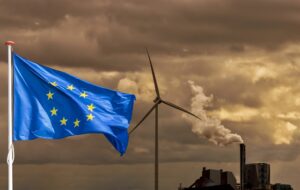On 2 July 2025, the European Commission presented a proposal to revise the European Climate Law in order to meet a 90% reduction in greenhouse gas emissions by 2040, compared to 1990 levels. The next key milestone for confirming this target is the meeting of European environment ministers scheduled for 18 September 2025. But why is a 2040 target needed? What is the political context shaping the process of updating the Climate Law? How does it relate to the EU’s NDC? This article aims to provide answers to these questions.
The EU’s 2040 target, and the pathway to achieving it, forms part of the broader framework of the European Green Deal, which views the decarbonisation of the European economy as a key lever to revitalise industrial competitiveness. The process began in early 2024, when the European Commission presented a recommendation for a 90% reduction target, accompanied by an impact assessment outlining several scenarios for reducing emissions by 2040.
Why set a mid-term emissions reduction target?
First, there is a scientific rationale. According to the 2023 assessments by the European Scientific Advisory Board on Climate Change, a 90% reduction would represent a fair contribution from the EU to meeting the goals of the Paris Agreement. Given that the European Climate Law commits the Union to climate neutrality by 2050, this proposal serves as a necessary intermediate step to ensure that total emissions remain in line with the Paris Agreement.
Secondly, the 2040 target responds to growing concerns over the increasingly visible and significant impacts of climate change. According to the latest Eurobarometer survey, 81% of Europeans are in favour of achieving climate neutrality by 2050, and a strong majority see EU climate policies as a top priority.
In addition, setting a 2040 emissions reduction target sends a clear signal to both the public and private sector, helping to guide investment towards innovation. This is a key element for revitalising Europe’s competitiveness at a global level, as outlined in the policy documents for Von der Leyen’s second term: the Competitiveness Compass and the Clean Industrial Deal.
Finally, at a time of profound geopolitical uncertainty, presenting an ambitious 2040 target would demonstrate the EU’s ongoing support for multilateralism and its premises. Alongside maintaining its leadership role in driving global climate action, greater European ambition could provide momentum in shaping the next round of national contributions to the Paris Agreement, which all 198 signatory countries must submit ahead of COP30, set to take place in Brazil this November.
Cutting emissions while boosting competitiveness
The European Commission has stated that, in designing the EU target and its accompanying legislative framework, it will consider opportunities for flexibility and simplification, such as the use of international credits under Article 6 of the Paris Agreement, “supporting both the EU and third countries with net emission reduction trajectories that are compatible with the Paris Agreement objectives.”
The Commission also aims to reduce dependence on fossil fuel imports in order to lower energy prices and boost industrial competitiveness. There is a renewed commitment for investment in renewables, the electrification of industrial processes and energy efficiency. Support is also being directed towards emerging technologies that are not yet mature, such as CO2 storage, while promoting innovation based on cost-effectiveness. At the same time, the Commission is emphasising the need to reduce social impacts to ensure a just transition.
Towards the 2040 target: 2035 NDC checkpoint
The 2040 targets, introduced via legislative procedure, are closely linked to the 2035 target (the European NDC), due to be adopted by an EU Council Decision on 18 September. The NDC represents an intermediate milestone towards 2040. Therefore, determining how to reach 2040 also means defining the trajectory to 2035. Currently, two main options are under discussion: a linear reduction pathway resulting in a 72.5% cut, or a more backloaded pathway with reductions concentrated after 2035, which could see a 66% cut by that date. However, acting swiftly would significantly reduce the costs and risks for the entire economic system associated with adapting to the worsening impacts of climate change, as also noted by the European Central Bank.
In an effort to speed up the approval process for the target and align it with the NDC timeline, progressive groups within the Von der Leyen majority — the Greens, Socialists and Democrats, and Renew Europe — last week proposed using an accelerated procedure to secure adoption of the 2040 target by 18 September. This approach is not unprecedented. Under the EU’s legislative process, emergency procedures have, for instance, enabled swift amendments to vehicle regulations, allowing the immediate introduction of flexibilities requested by manufacturers, without putting the regulation through lengthy revisions or undermining its overall integrity.
However, in this case, the motion for fast-tracking the EU Climate Law was rejected by the European Parliament due to opposition from the European People’s Party. The far-right group Patriots for Europe has since taken charge of this dossier during the ordinary legislative procedure, which is the process that this proposal will have to follow. As such, far-right groups will now be responsible for scheduling the debate and initial drafting of the European Parliament’s position, which, after negotiations with the Commission and Council, will shape the EU’s position. Given this political group’s longstanding opposition to the Green Deal, it is reasonable to expect obstructionist positions and delays in the approval of the target, raising the risk of setbacks for both the Climate Law and the NDC approval process. Without approval of the 2040 target by September, the likelihood of adopting a less ambitious NDC, closer to 66%, increases significantly.
A coherent policy framework is essential to building a long-term vision, now more crucial than ever to avoid ineffective or counterproductive policies even at a national level. For this reason, the debate over the 2040 target should not become a partisan battleground, but rather be viewed by all sides as an opportunity to boost European industrial competitiveness.
Photo by Tim van der Kuip







